Augmented reality (AR) continues to shake the digital world. Unlike virtual reality (VR) that creates a world that doesn’t physically exist, AR works with the real objects placing texts and images in front of our eyes. That makes the technology extra useful in daily life.
Two years ago, tools for AR development were first integrated into Android and Apple iOS, and last year lots of brands and organizations decided to strengthen their apps with AR-powered features. Ikea, WWF, Gucci, and Toyota were pioneers who built an augmented reality app as a self-standing marketing product.
Due to mobile capability growth and Internet speed-up AR is now accessible from regular mobile devices. No surprise that in 2018, we saw the AR startup boom. Navigation, architecture, industry, and healthcare became major areas for AR app developers to focus on.
In the article, we’ll try to figure out how to make an augmented reality app, what is the cost of it, and if it could be profitable in your particular case.
Business Potential and Benefits of Augmented Reality Mobile App Development
The augmented reality concept isn’t new. In 1992, it was first implemented by Louis Rosenburg (USAF Armstrong’s Research Lab), who wanted to provide workers with additional information they required to execute actions with physical objects. Their characteristics and additional data had to be shown atop of objects which were believed to save time usually spent by workers on checking objects’ technical passports. These days, a similar concept improves production efficiency at Boeing airplane factories.
However, one can develop an augmented reality app not just to speed up industrial production. The scope of AR has grown since then, and now the technology can be used to simplify almost any business action or daily duty. Here are some examples of AR benefits for the business sector:
- Increasing the efficiency of employees by automatically providing them with the necessary information about their ongoing tasks
- Increased production accuracy
- Cheap production process due to the possibility of virtual project testing
- Ability to hire professionals and work with them remotely, while avoiding language barriers
- Increased customer engagement
Most startupers ask themselves how to build an augmented reality app aiming to benefit from private customers, not companies. As small personal gadgets are now a way to access augmented reality, there is a certain demand on mobile apps for daily life such as AR-based language teaching tools, AR navigators, apps for thoughtful shopping, and much more. It is also predicted that in 3 years AR will dominate the digital market.
The creative AR market potential is predicted to reach $27 billion by the end of 2025. And in 2018, the areas where the level of AR adoption and AR development investments dramatically increased were automotive, media, healthcare, retail, HoReCa and industry.
Who Needs an Augmented Reality App Development?
Mobile app AR introduction unlocks numerous opportunities for business and social initiatives. Better user engagement, budget-saving, products, and services quality improvement are just a couple of examples. However, each business field has its augmented adoption specifics. Let’s find out how to create augmented reality apps for Android or iOS that will multiply your profits.
Advertising & Marketing
Creating an augmented reality app for your customers to increase their loyalty level, raise marketing campaign conversion, and receive positive feedback — that is what the most popular mobile AR approach looks like. The global statistics prove that: digital advertising market is expected to be estimated at $335 billion by the end of 2020 which is 30% more than this year. At the same time, AR shows the best engagement rate among all other means of bare online advertisement.
Why AR-based ads are so effective? First, they could be super local and super focused.
This technology allows you to convince potential buyers inside the store or at its storefront, instantly picking up arguments in favor of a particular product. The fewer time shoppers spend thinking, the more money they spend. Augmented reality reduces thinking time and can make a purchase either emotional or thought-out due to quickly provided product information. And yes, the more focused the ad is, the less money we spend on it.
Better engagement level is the other advantage of AR marketing. No matter what type of ads you use, it always provides customers with intriguing user experience and looks a bit like a game.
Virtual try-on is a unique feature of AR apps. The lack of the opportunity to try on goods is the most critical drawback of online shopping.
With mobile AR there are no more shopping hesitations — simply point the phone at your room to see how the new Ikea sofa will look in it, or point the camera at your hand to try on a new Gucci bracelet!
Medicine
Augmented reality is changing both medical education and the healthcare industry. The technology is considered to be more cost-effective and useful there comparing to virtual reality and mixed reality that tend to keep medical workers on a certain distance from the real human body.
There several branches of healthcare AR adoption:
— AR head-mounted displays (HMD) for surgery
Surgery is less risky if it lasts a minimum of time. Augmented reality technology allows doctors to instantly get acquainted with information about the patient's condition and its allergic reactions. Example — Viking Systems stereoscopic medical HMD.
— AR for diagnostics and minimally invasive surgery
Augmented reality allows additional information to be projected on top of the objects to which it relates. The technology literally helps doctors see through the patient’s skin, projecting their bones, tissues and blood vessels onto the skin. Examples — ProjectDR and AccuVein scanner.
— Home-based AR for rehabilitation
You can also make an augmented reality app for private users. An app could monitor your body's vital signals and send them to the doctor. In this case, the doctor can conduct a routine examination of the patient virtually, which saves time and reduces the cost of the procedure. Some equipment oversees the process of psychological rehabilitation, helping patients return to their usual rhythm of life. Example — MindMotionPRO.
— AR medical education
Students will now be able to conduct virtual operations, test their skills and learn new medical disciplines using AR headsets. This approach accelerates the study of disciplines and speeds up profession initiation.
Lifestyle
How to make an AR app which would be demanded across the world? Take into consideration human habits, tastes, fears, and pains and design the solution that will make people’s everyday life simple and full of joy. There is no single way to use augmented reality concepts and gain significant revenue. However, we advise you to look upon such emerging areas:
— AR painting
Most likely, you’ve already seen demos in which people create 3D paintings using a virtual palette and brush. In that case, it was about VR. At the same time, modern mobile AR allows a person to draw on top of real objects, save the masterpiece and show it to others. Social AR art is a new trend. Example — Paint Space.
— Navigation and traveling
Perhaps an on-board computer can plan a good route for you. But what if we imagine a world in which we don’t need to be distracted by viewing a navigator or interactive mobile map. Augmented reality navigation and head-up displays (HUD) will help drivers to be more careful on the roads and decrease the risk of accidents. Example — Where to?, Compass360, LocalScope.
— Daily assistance
Not all routine tasks can fit in the head of a modern person and an AR assistant can do much more than a mobile notebook with a reminder mode. With the help of a camera, the virtual assistant scans what surrounds us and tells how to optimize the performance of everyday tasks.
— Understanding others
Google Translate is one of the vivid examples of using augmented reality while communicating with other people. With the help of AR technology, we can automatically understand what foreigners are saying and be understandable to them. We could also understand signs and written articles without knowing a foreign language.
— Fashion and beauty industry
Each of us wants to be sure that the next haircut will suit us, the makeup will emphasize attractive aspects of our faces, and the dress will look stunning. Augmented reality allows us to execute a virtual fitting and adjust our appearance to find our style. Example — Mary Kay Mirror Me, Tissot — Augmented Reality Watch Try-On at Selfridges.
Entertainment Industry
The gaming and entertainment industry are now the major areas of AR implementation. Although the gaming industry, unlike healthcare, does not save lives, the main investments and profits concerning augmented reality are concentrated here. The mobile gaming niche is now estimated at $209.5 million and it forms half of the global gaming profit being the third most popular app category.
But what about AR mobile gaming?
AR games work as open-world ones based on the real world. They use human living space as a gaming arena and allow you to share the gaming experience with others.
The pioneer VR-based app was Pokémon Go that gained a record of $207 million revenue in its first month and got 60 million monthly active users within one year. The game matches real-world maps and objects with virtual world creatures and pushed users to measure their strength in virtual battles.
Other AR gaming app examples — Ingress, ARrrrrgh, Sharks in the Park, and WallaMe.
There also lots of entertainment AR apps examples that couldn’t be named games. Some of them simply transform the reality that surrounds you into the scenery of famous films and series. For example, you can apply the lens to make your room look like a castle from the Games of Thrones.
Retail & E-commerce
Augmented reality marketing campaigns can enhance online and offline sales no matter what kind of goods you deal with. The very first problem of e-commerce is a high risk of making mistakes ordering products you expect to look in a certain way.
Customers can make a mistake with the size of shoes, buy a suit in the store, the color and texture of which will not suit them, or purchase furniture that will look like an alien in the room. These risks inhibit online shopping and lead to the fact that the client is unsatisfied with the purchase or does not do it at all, doubting the quality and characteristics of the product. A virtual fitting feature accessible through the AR app is the solution.
Another way to increase profits by integrating augmented reality technology into your store’s application is customer information support. If you have a physical store — an app can act as an assistant, which provides complete information about the goods on the shelves. If you have a chain of stores or your product is presented at different points of sale, an app may tell you where to look for sales.
Education
The educational sector is not a profitable sphere of augmented reality implementation, however, along with science, investment in the development of AR-based techniques can bring the world to a new level of technical development and equality. How can AR technology be applied in universities and schools? Find our ideas below:
— Lessons supported by visual material
Example — in astronomy class, students can use gadgets to consider three-dimensional models of planets and star systems.
— Executing tasks inside the AR simulator
Example — students of technical faculty will be able to assemble an engine using tablets and virtual parts.
— Learning outside the classroom
Example — learn foreign languages while walking around the city. Use your mobile device to learn the names of surrounding objects in French or Italian.
— Distance learning
Augmented reality will make learning more effective and increase its accessibility for third world countries. Example — virtual classes, which can be accessed for free.
Augmented reality apps development for better education is at its starting point. At the same time, the education sector is the third one that shows constant development within this year. In 2019, 36% of all AR apps were made for educational purposes. Check some successful AR apps for pupils — Google Expeditions, Catchy Words AR, and Curioscope.
Real Estate & Architecture
Augmented reality application development was recently spread in the construction area. The AR approach in real estate trading as well as in architecture and construction is aimed to make companies more cost- and time-effective and help them to meet their customers’ expectations.
We could assume that most of the useful solutions within this area will appear in the nearest years. However, some of the breathtaking ideas have already become possible. Find them below!
— Check your future estate before it is constructed
AR cloud technology allows investors to see what their house or flat will look like even before construction starts. That will help them to make thoughtful decisions and be sure that future estate will fit their tastes and lifestyle. Same works for already existed buildings where you could enter virtually. Example — Homesnap app.
— 3D model of future buildings
AR could be useful in lots of construction stages — from modeling to final decorations. AR app for architects will allow them to work on the project deeper and make it more cost-effective. AR app for engineers can show them information on materials and construction details and save their time. In general, AR will put the industry on a new quality level.
— Home improvements
House owners can easily change the interior, create decoration details and be sure they will look terrific. With AR app such as Ikea Place, users can place any 3D model from the catalog inside their homeplace and decide whether it fits the interior or not. The approach helps Ikea sell more and build strong relations with its customers.
Industry
Augmented reality can be a powerful tool for production companies, industrial concessions, and small manufacturers. The technology gives their owners and workers lots of advantages.
First of all, AR gives us a chance to see the product before it is physically built. Virtual models can be shown to focus group to find out which one will be more demanded by the target audience. The virtual MVP approach saves money even better than a regular one!
Second, AR headset for workers makes their work accurate, fast and easy to be monitored. Engineering mistakes cost a lot — that’s why aircraft and car factories were among the first AR apps adobes.
Third, augmented reality app speed up all kind of industrial processes providing workers with all kind of appropriate tech information on tools, constructing details, materials, and ready products. Together with IoT and AI technology, it turns factories into organisms where all team members are linked smartly and effectively. Such an approach optimizes the industrial work chain.
Industrial companies that use AR apps — Boeing, Range Rover, Porsche, and Caterpillar.
Create AR App! How Augmented Reality Apps Work
Augmented reality apps can solve various tasks nevertheless all of them have a feature in common. AR apps bring digital data into the physical world and place virtual objects atop of real ones. The technology allows us to interact with each other avoiding user experience and virtual isolation which is the main feature of virtual reality.
Let’s name key types of AR!
Marker-based Apps
Augmented reality app development cost depends on the complexity of your app and the complexity in its turn depends on the task you’d like to solve. Marker-based AR is now the cheapest way to implement the approach inside your product.
To place a virtual object onto a real one on your screen, the device should recognize the object and find the proper place for information box or animation. In this case, the marker is a trigger for AR data performance to start.
AR markers could be anything. The cheapest option is to put any easy-to-scan 2D tags on the object surface. 2D objects with edges and corners are extremely effective. Example — ScanLife, Popcode, and Google Goggles.
AR mobile app could also use smart recognition technology which is called marketless — the one where AI helps to recognize real-life objects without special markers (furniture items, faces, plants, etc.). Examples — ARIS, Layar, and Google’s Tango.
Location-based Apps
Planning to build an augmented reality app for travelers, drivers or dedicated open-world gamers? Be sure, you’ll need to use location-based AR technology which uses GPS as a major tool.
Although the Global Positioning System (GPS) was launched in 2000 and is still used mainly for regular navigation, most of the modern apps have access to its data. For example, Facebook, Instagram, Netflix app, and Google itself track your location constantly. So why not to use GPS data to show us virtual animation?
Location-based apps overlay digitized data on physical places using mobile location awareness capabilities powered by GPS module, gyroscope, digital compass, and accelerometer.
Simulating Real-Life 3D Objects
Augmented reality technology can not just put a virtual data atop of objects you can touch and smell, but can scan any real-life object, create its digital copy and then put it to cloud storage.
How to make an augmented reality app of that kind profitable? Think of those who need to work with the same constructional items every day according to their professional duties. Interior designers, decorators, architects, and engineers will benefit from the technology a lot. Examples — Housecraft, Ikea Place, and Magicplan.
3D objects simulations can be used for the educational purpose also. Moreover, such an approach brings gaming experience into the study process which raises student’s engagement.
3D scanning technology is sensor-based. Examples of 3D objects operating mobile VR apps — Layar, AR-3D Science, and AR Freedom Stories.
Browsers Showing User Location
There will be no need to find the answer to the question “How to build an augmented reality app?” if mobile web augmented reality is powerful enough to meet our needs and expectations. In 2019, the in-built AR module for Chrome was launched, and other brands like Apple, Samsung, and Microsoft that have their browsers decided to follow Google’s example.
What’s the difference between app-based and web-based AR? The second one doesn’t need any app installation to be started. You just open the link on your mobile device browser and get the same functionality level as an AR app has.
Examples — WebXR-powered sites for Chrome.
Real-Life Interactions
AR with real-life interaction options is not a self-standing type of augmented reality apps. At the same time, AR that requires real physical from its users and mixes together fancy virtual elements and interactions with life objects are most demanded. Remember Pokémon Go with its record revenue gained within the first month after launch? That what we are talking about!
Gaming AR that makes people move and turns life into a funny challenging activity is extremely engaging. But it’s not only about games but also about comfort. Some AR apps include a real-life interaction option because they were simply designed for various navigation purposes. Examples — Gatwick airport passenger app helps you to find your way in the airport, place to charge your phone or chair to sit behind the window.
Augmented Reality App Development Cost
To come up with a precise budget, first, you need to pass the discovery and preparation stages. Finalizing your app idea, market research, target group search as well as listing key features and functions of your app are among them. To look deeper into the app development process, check our article How much does it cost to make an app. And here, we’d like to give you basics on AR app development.
Rates of the Augmented Reality App Development Company
Augmented reality app can solve different human life tasks. Regarding the type of a task, your target audience, market situation, and other factors, you may choose an agency that could develop your product. Three main points that usually influence AR app development budget:
— App scope and complexity
To answer the question on how difficult is to implement your idea, you need to figure out what kind of features are critical for its MVP (read our article on Minimum Viable Product development), if its logic is complex or not, what sort of UX and UI you’d like to have, and if you need some niche expertise to manage and promote the project.
— Deadlines
If you’d like to launch your product soon — you need to spend more money on hiring a few more developers and designers to speed up key processes. That is also true that professionals tend to make fewer mistakes and work faster. On the other hand, they cost more.
— Team and work style
First, you need you to know what types of workers you need regarding features you want to have inside your AR app. Second, you need to choose between in-house and outsource development. Then, you may choose the type of outsourcing — you can choose a development company from your town or another country, and that is also an option to find freelance developers.More about dedicated development and outsourcing.
Keep in mind, that augmented reality app development needs skilled developers with high hourly rates even in those countries that are considered to be cheap in terms of remote development. Developers from India will cost you $25 per hour, from East Europe — not less than $40, and from North America — $150.
Developing Augmented Reality App. Chosen SDK
Software Development Kit (SDK) is a pack of tools that your team may use to make the development process faster and avoid future errors. With the help of SDK, you can add special features to your product as well as adopt it to various operating platforms.
How to choose the right SDK? First, you need to analyze your project goals and management style. The tech stack for your app (marker-based, projection, GMS-based, or superimposition) should be chosen by your team regarding the type of app you are going to launch. Some factors would influence their decision:
- target operating platform
- best known programming language
- native AR tools support (Microsoft HoloLens, Magic Leap)
- possibility and frequency of AR app updates
- monetization concept and licenses
The SDK choice will impact the final develop price. At the same time, the right tech solution will save your money on future product improvements and promotion campaigns. Take into consideration, that some SDKs are paid.
The most popular AR content creation platforms — Vuforia for Unity AR engine (499$ as a single purchase), Kudan which is free for independent developers and costs more than $1200 for others, Apple ARKit that is free for those who have Apple developer account, and Google ARCore which is free.
Each of the SDK has its tech limitations. Check them before coming up with a final solution.
The Application Complexity
Augmented reality business applications are various. According to the Lean Startup concept, it is always better to start with an MVP (Minimum Viable Product) to study if there is any demand for your idea, what should be improved to attract more users, and if your tech solution is stable.
Nevertheless, not every mobile AR app could be launched as an MVP (in other words — a product with only essential functions), as all of AR app features are likely to be important. Below, we are trying to describe the differences between 3 development approaches applicable for mobile AR.
— Demo model
cheapest option; good for small startups
AR features development is the most expensive part of app development in general. To reduce risks of creating an expensive product that no one really needs, create a video or a short demo with a small number of AR objects available for testing from your website. An AR demo app could be also published in the App Store and Google Play Market.
Such an approach will help you to find out if your product is interesting for the target audience and study its behavior.
— AR app with only basic features and a couple of secrets
medium price; good for independent developers
The difference between this type of app and AR MVP app is that its users can not just test your idea and then just wait for its full version, but they have an opportunity to benefit from an app. You’ll have to give the priority to those features that shape your Valuable Market Proposition and make your app special comparing to competitors’ ones.
If you work out a game — you need to integrate a sign-in feature and charts there. If your idea is to create an educational platform — make sure it could provide students useful experience and give them an option to share content on social networks. Most apps of that kind work with a 3D items catalog to save user mobile resources.
— Full-scope AR product
expensive; works for big enterprises
In general, AR development is both expensive and extremely rewarding. And there are some AR fields where you can’t just make an MVP — the only way is to spend time on the area discovery stage, try several approaches, and test the product to be absolutely confident about its quality. AR apps for hospitals, industrial institutions, military purposes, and navigation are of that kind.
In this case, you need to execute accurate calculations on development costs. If you represent an institution of the non-digital area that needs an AR app to improve the efficiency of work, you need to hire the dedicated developers' team with expertise in your are.
The most common features of powerful AR apps — AI-based options, object recognition, 3D models library access, content management system, and sign-in feature. The rest will depend on the practice area you are working in and app purposes.
Conclusion
AR and VR industries are still not fully separated from one another — they use similar technologies and tend to become accessible from the same devices. However, that is believed that augmented reality will soon get ahead of the virtual one as it has wider practical usage scope and no solo experience drawbacks. By the end of 2023, the industry will reach $160 billion and become the major mobile development area. Compare it with $16.8 billion of 2019!
The highest growth development rates of 2020—2025 will be reached by AR hardware industry (68%), AR commerce (78%) and AR-based communications (66%). And such sectors as AR gaming, healthcare AR tech development, and AR for engineering will generate the highest revenue within the next 5 years.
Consider that to create an augmented reality app you need to spend more time and money compared to regular app development. You’ll also face difficulties looking for skilled developers for your project. AR development itself is challenging as well — in most cases MVP approach is not applicable for it. However, it has enormous revenue potential that may inspire you.
What we could recommend is to study from the leader's experience and follow the AR market news. New devices and 5G Internet standards are coming and they are expected to change the market!


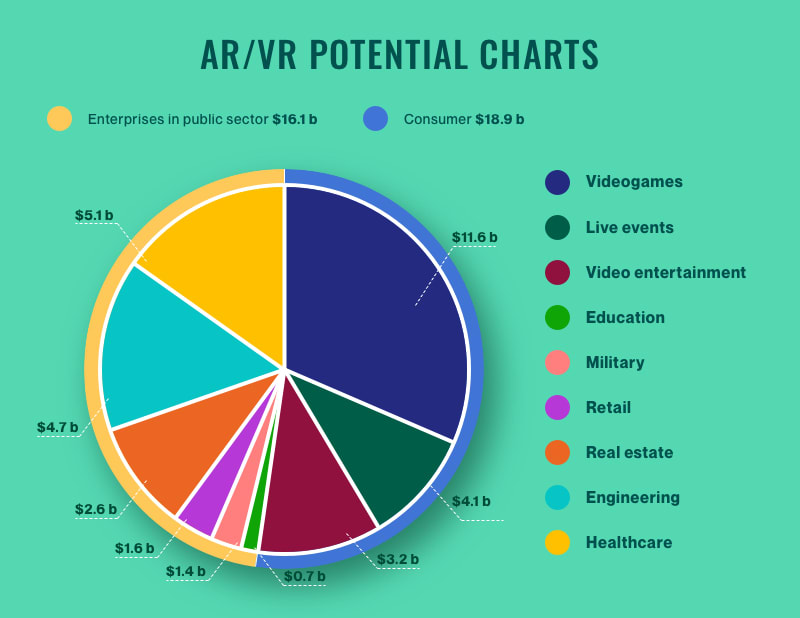
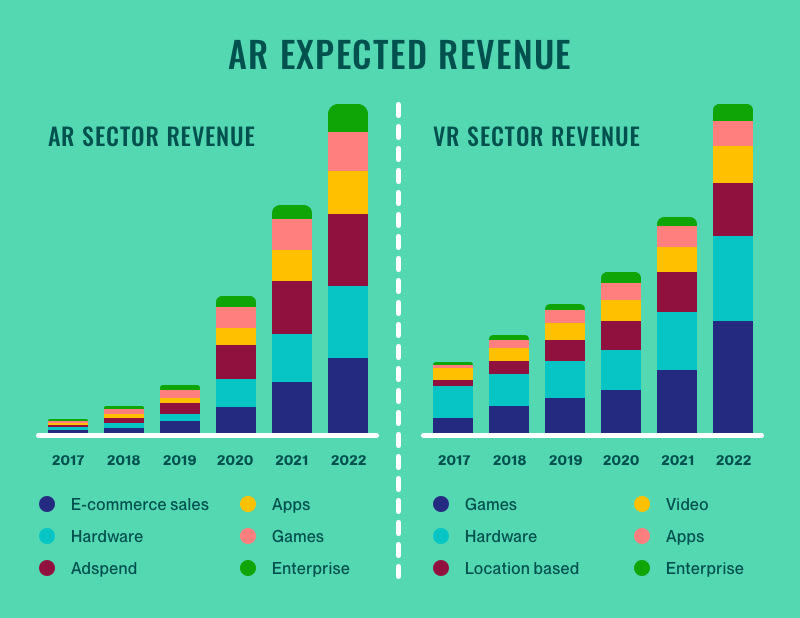
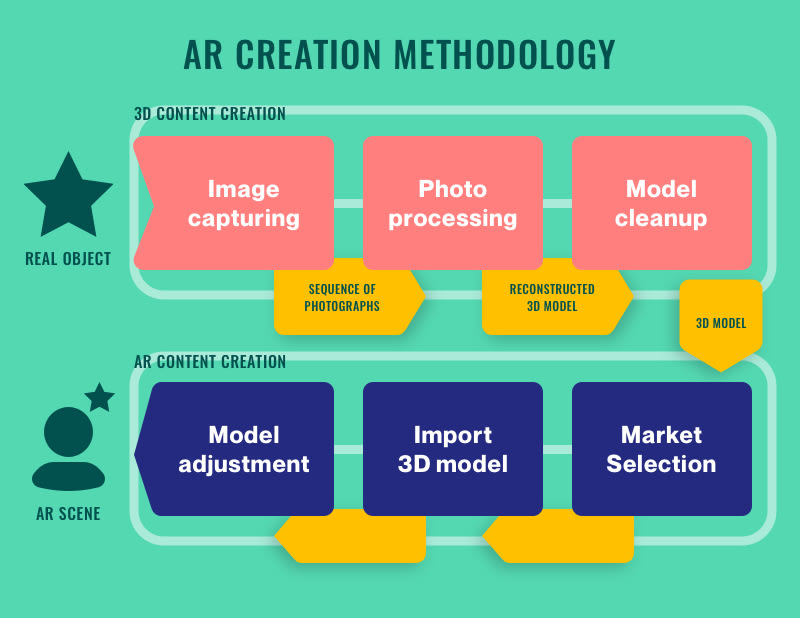
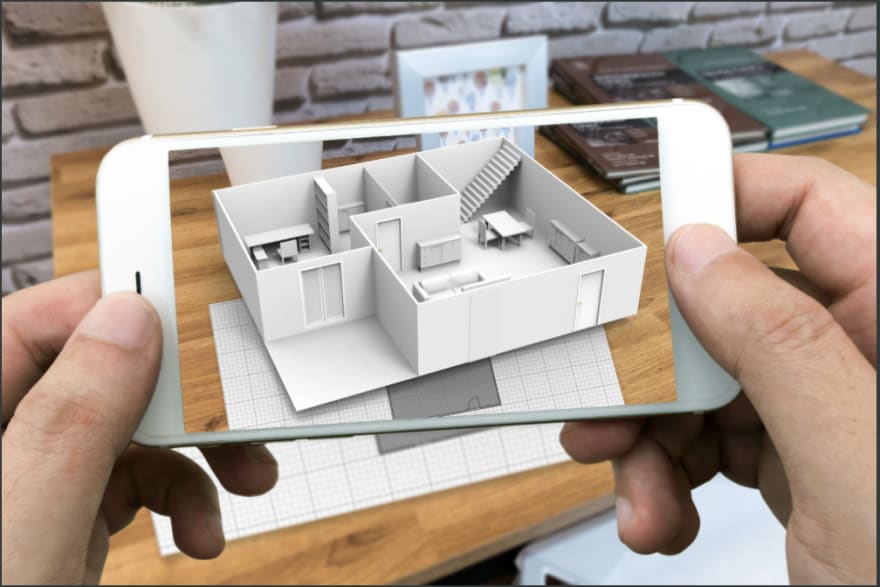
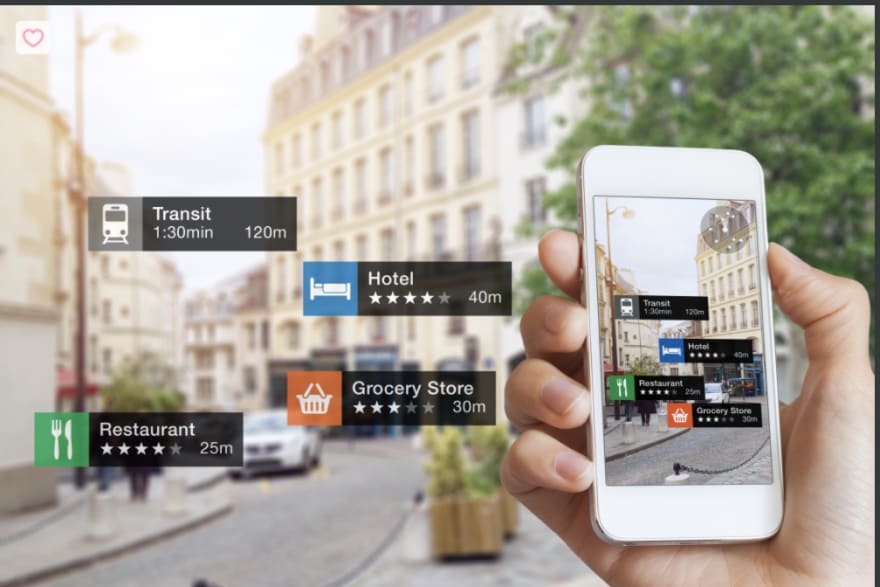
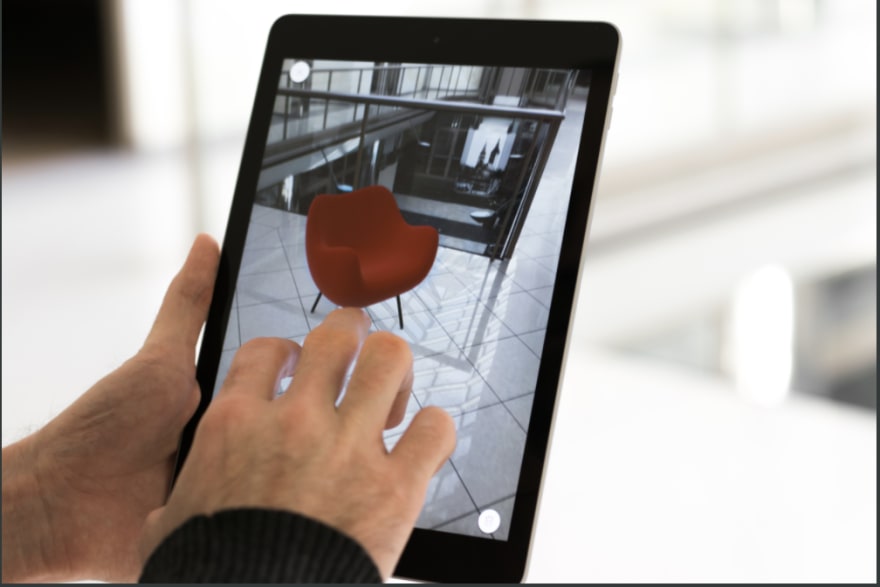
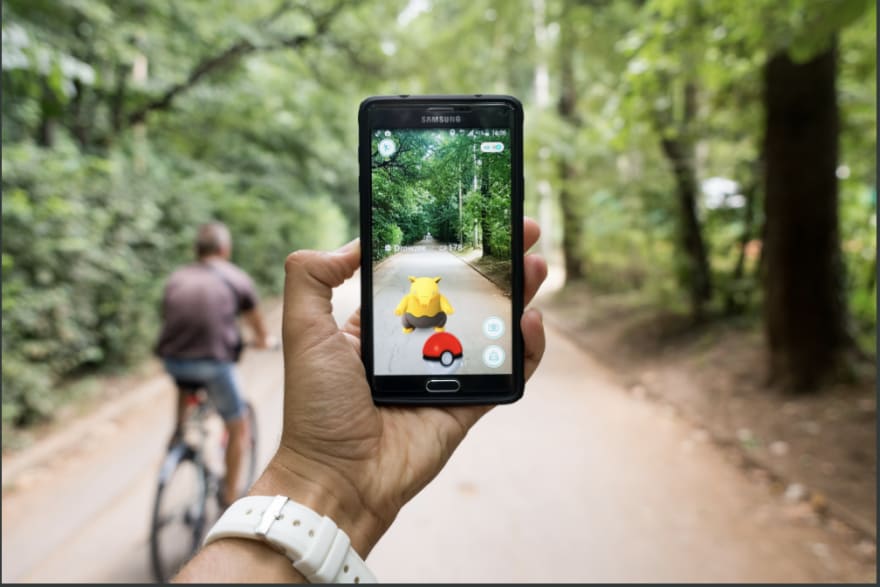





Latest comments (0)
Some comments may only be visible to logged-in visitors. Sign in to view all comments.